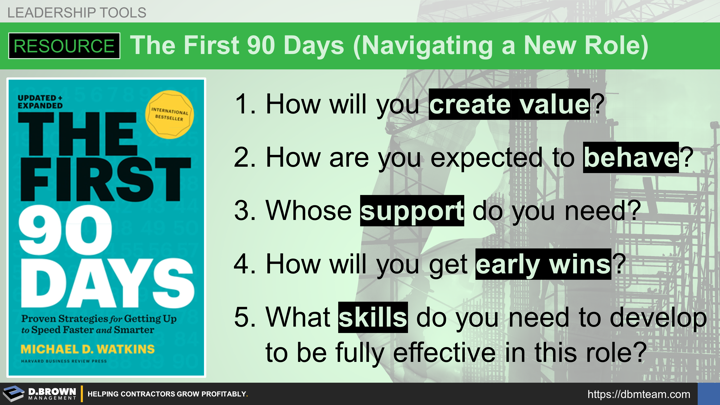Michael Watkins is a leader in the area of job role transitions codifying many of the principles, challenges, strategies, and tactics that can be used in various situations.
While most of his experience and examples are from companies much larger than all but a handful of contractors, we have been able to successfully apply them to all roles from Foreman to Project Manager to President at contractors in all stages of growth. This starts with The Five Key Questions for a New Role:
- How will you create value?
- How are you expected to behave?
- Whose support do you need?
- How will you get early wins?
- What skills do you need to develop to be fully effective in this role?
These questions are framed from the perspective of the individual. Turn them around and ask them from the perspective of the manager of that person and from their manager (Manager-Once-Removed or MoR):
- Do you clearly know what you need this person to do and is it clearly defined in their job role description?
- Do you have clearly defined behavioral expectations including non-negotiable behavioral boundaries for the company as a whole and for this role? Are they being consistently followed considering that culture is defined by the worst behavior knowingly tolerated by leadership.
- Are there clear workflows defining who does what and by when within your business model? What are the informal networks that this role will require support from directly or indirectly? How are those communicated?
- What are early wins that would signal they are on the right track in your eyes? In the eyes of others in the organization?
- Based on your evaluation of the person and knowledge of the role, what are the biggest skill gaps they need to close? Are those hard or soft skills? What is your plan to help them develop those skills and how will you know if they are on-track?
As you can see, those questions are VERY difficult whether you are the person moving into the new role, their manager, or above.
Successful Leadership Transitions (25 Minute Overview)
Great 25 minute overview of the principles, strategies, and tactics from The First 90 Days. Terrence Donahue interviews Michael Watkins about how the concepts are applied in a custom tailored course for Emerson as part of their plan to combat the leadership crisis. Key points include:
- The 80/20 balance of internal leadership promotions to external recruits
- What level to bring external leadership recruits in at
- The First 90 days and the Next 90 days
- The seven drivers of success (below)
- Identifying the situation you inherited (below)
Categories of the Role Requirements (Value-Add) and Transition Roadmap
- Startup
- Turnaround
- Accelerating Growth
- Realignment
- Sustaining Success
Most role transitions require a combination of these and a great transition roadmap is laid out in this five minute video.
- Accelerate your learning
- Match strategy to situation
- Secure early wins
- Negotiate success
- Achieve alignment
- Build your team
- Create alliances and coalitions
These are explored much deeper in the book (The First 90 Days), in the book summary, and in this 1-hour video from MIT.
As you dive into this, you will notice similarities to the Stratified Systems Theory (SST) model as you hear Michael Watkins talk about The Seven Seismic Shifts that occur when the role transition is to a different hierarchal level of the company's org structure including simply growth of the organization:
- From Analyst to Integrator
- From Bricklayer to Architect
- From Specialist to Generalist
- From Supporting Cast to Lead Role
- From Tactician to Strategist
- From Warrior to Diplomat
- From Problem Solver to Agenda Setter
Mastering job role transitions is critical for contractors in all stages of growth and especially for succession. The challenges are being compounded by talent shortages at the craft level and demographic tightening of the talent market for higher-level management and leadership positions.
Please remember that these principles, strategies, tactics, and tools all need to be tailored to the role and company.
Please also remember that not all role transitions require a change in title, company, or project. Doing the same role in a company at a different stage of growth or market condition has very different role requirements. Being President of a 50-person contractor is very different than being President of a 150- or 500-person contractor.
Please don't hesitate to contact us to discuss how we've seen role transitions managed both good and bad. We will share freely with you anything we can to help. All relationships begin with a simple conversation.

